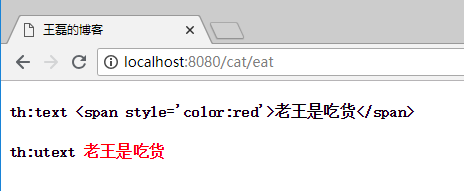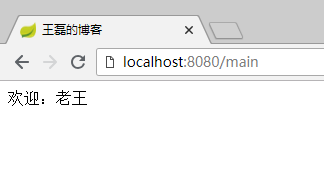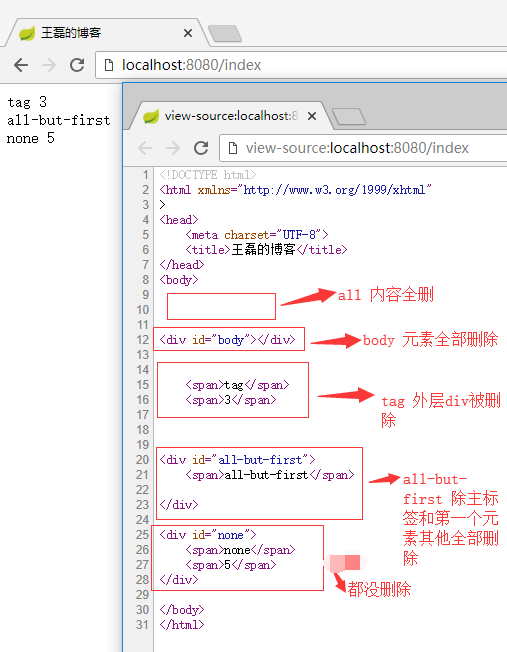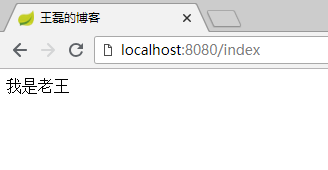Thymeleaf是一种Java XML / XHTML / HTML5模板引擎,可以在Web和非Web环境中使用。它更适合在基于MVC的Web应用程序的视图层提供XHTML / HTML5,但即使在脱机环境中,它也可以处理任何XML文件。它提供了完整的Spring Framework集成。
关于Spring推荐Thymeleaf的这种说法,我在Spring官方文档并没有看到具体的说明,只是在和JSP比较的时候,说了JSP和Thymeleaf对比JSP的一些不足,而Thymeleaf只是作为其他模板引擎的一种代表。
作为一款优秀的模板引擎,除了易用性、活跃的社区、健康快速的发展外,还有非常重要的一点就是性能了,那Thymeleaf 3 和 FreeMaker 的性能对比是怎么样的,后续文章会陆续更新。
Thymeleaf的使用是由两部分组成的:标签 + 表达式,标签是Thymeleaf的语法结构,而表达式就是语法里的内容实现。
通过标签 + 表达式,让数据和模板结合,最终转换成html代码,返回给用户。
Thymeleaf基础使用分为三部分:
HTML代码:
<!DOCTYPE html>
<html xmlns="http://www.w3.org/1999/xhtml"
xmlns:th="http://www.thymeleaf.org">
<head>
<meta charset="UTF-8">
<title>王磊的博客</title>
</head>
<body>
<span th:text="${name}"></span>
</body>
</html>Java代码:
@RequestMapping("/")
public ModelAndView index() {
ModelAndView modelAndView = new ModelAndView("/index");
modelAndView.addObject("name", "老王");
return modelAndView;
}最终效果: 老王
使用"th:text"是对内容的原样输出,使用“th:utext”可以进行html标签输出。
Java代码:
@RequestMapping("/eat")
public ModelAndView eat() {
ModelAndView modelAndView = new ModelAndView("/cat");
modelAndView.addObject("data", "<span style='color:red'>老王是吃货</span>");
return modelAndView;
}HTML代码:
<h4 th:text="'th:text '+${data}"></h4>
<h4 th:utext="'th:utext '+${data}"></h4>展示效果:

<span th:if="${age > 18}">
成年
</span>
<span th:unless="${age > 18}">
未成年
</span>th:if为满足条件的业务处理,th:unless正好相反,是除去的意思。
<div th:switch="${age}">
<span th:case="18">18岁</span>
<span th:case="19">19岁</span>
<spa th:case="*">其他</spa>
</div>注意: 默认选项使用th:case="*" 指定。
HTML代码:
<div th:each="name,item:${names}">
<span th:text="${item.count}"></span>
<span th:text="${name}"></span>
</div>Java代码:
@RequestMapping("/")
public ModelAndView index() {
ArrayList<String> names = new ArrayList<>();
names.add("java");
names.add("golang");
names.add("nodejs");
ModelAndView modelAndView = new ModelAndView("/index");
modelAndView.addObject("names",names);
return modelAndView;
}访问效果如下:

其中item为每行的详细值,key值如下:
footer.html页面代码:
<!DOCTYPE html>
<html xmlns="http://www.w3.org/1999/xhtml"
xmlns:th="http://www.thymeleaf.org">
<head>
<meta charset="UTF-8">
<title>王磊的博客</title>
</head>
<body>
<div th:fragment="copyright">
? 著作权归 老王 所有
</div>
<div th:fragment="about">
关于
</div>
<div th:fragment="links">
CCTV
</div>
</body>
</html>声明了两个代码片段,copyright和about。
cat.html页面代码:
<!DOCTYPE html>
<html xmlns="http://www.w3.org/1999/xhtml"
xmlns:th="http://www.thymeleaf.org">
<head>
<meta charset="UTF-8">
<title>王磊的博客</title>
</head>
<body>
<div th:replace="footer :: copyright"></div>
<div th:insert="footer :: about"></div>
<div th:include="footer :: links"></div>
</body>
</html>其中第一个div引用了footer.html 的 copyright 代码片段,第二个div引用了 footer.html 的 about 代码片段。
双冒号的理解: 其中使用“::”双冒号来完成对页面片段的引用,有点像php里面的语法,使用双冒号来表示对类的静态属性和方法进行直接引用。
执行效果如下图:

总结: 可以很清晰的看出th:insert、th:replace、th:include之间的区别,在于是否保留自己的主标签,th:include 在3.0之后已经不推荐使用了,可以使用th:replace标签替代。
使用fragment我们是可以在html代码中传参的,比如我们定义了一个top.html其中有一个“欢迎XXX”的提示,而这个人名XXX就是需要动态传递的,这样我们可以最大程度的完成代码的复用,这个时候就是一个很好的使用场景,我们需要这样做。
页面main.html代码:
<!DOCTYPE html>
<html xmlns="http://www.w3.org/1999/xhtml"
xmlns:th="http://www.thymeleaf.org"
>
<head>
<meta charset="UTF-8">
<title>王磊的博客</title>
</head>
<body>
<div th:replace="footer :: webcome('老王')"></div>
</body>
</html>页面top.html
<!DOCTYPE html>
<html xmlns="http://www.w3.org/1999/xhtml"
xmlns:th="http://www.thymeleaf.org"
>
<head>
<meta charset="UTF-8">
<title>王磊的博客</title>
</head>
<body>
<div th:fragment="webcome(about)">
<span th:text="'欢迎:'+${about}"></span>
</div>
</body>
</html>最终的效果:

页面代码:
<!DOCTYPE html>
<html xmlns="http://www.w3.org/1999/xhtml"
xmlns:th="http://www.thymeleaf.org"
>
<head>
<meta charset="UTF-8">
<title>王磊的博客</title>
</head>
<body>
<div th:with="sum=4-2">
<span th:text="${sum}"></span>
</div>
</body>
</html>页面输出结果:2
th:remove用于html代码的删除,th:remove值有五个:
示例index.html代码如下:
<!DOCTYPE html>
<html xmlns="http://www.w3.org/1999/xhtml"
xmlns:th="http://www.thymeleaf.org">
<head>
<meta charset="UTF-8">
<title>王磊的博客</title>
</head>
<body>
<div id="all" th:remove="all">
<span>all</span>
<span>1</span>
</div>
<div id="body" th:remove="body">
<span>body</span>
<span>2</span>
</div>
<div id="tag" th:remove="tag">
<span>tag</span>
<span>3</span>
</div>
<div id="all-but-first" th:remove="all-but-first">
<span>all-but-first</span>
<span>4</span>
</div>
<div id="none" th:remove="none">
<span>none</span>
<span>5</span>
</div>
</body>
</html>最终展示效果如下:

<div th:style="‘color:‘+${skinColor}"><input type="button" value=" Click " th:onclick="‘onsub()‘"><a th:href="${myhref}"></a><input th:value="${user.name}" /><img th:src="${img}" /><form th:action="@{/suburl}"><form id="${fromid}"><img th:attr="src=@{/img/stone.jpg},alt=${alt}" /><div th:object="${user}">变量表达式:${...}
选择变量表达式:*{...}
消息表达式:#{...}
链接表达式:@{...}
片段表达:~{...}
文字:‘one text‘, ‘Another one!‘,…
数字文字:0, 34, 3.0, 12.3,…
布尔文字:true, false
NULL文字:null
文字标记:one, sometext, main,…
字符串拼接:+
字面替换:|The name is ${name}|
二进制运算符:+, -, *, /, %
减号(一元运算符):-
二进制运算符:and, or
布尔否定(一元运算符):!, false
比较值:>, <, >=, <=
相等判断: ==, !=
如果-然后:(if) ? (then)
如果-然后-否则:(if) ? (then) : (else)
违约:(value) ?: (defaultvalue)
所有以上这些表达式都可以组合和嵌套,例如:
‘User is of type ‘ + (${user.isAdmin()} ? ‘Administrator‘ : (${user.type} ?: ‘Unknown‘))
变量表达式的使用,我们前面的代码已经见到了,$是我们平常开发中最常用的表达式,用于把后台Java类的动态数据,映射到页面,例如:
Java代码:
public ModelAndView index() {
ModelAndView modelAndView = new ModelAndView("/cat");
modelAndView.addObject("data", "我是老王");
return modelAndView;
}HTML代码:
<!DOCTYPE html>
<html xmlns="http://www.w3.org/1999/xhtml"
xmlns:th="http://www.thymeleaf.org">
<head>
<meta charset="UTF-8">
<title>王磊的博客</title>
</head>
<body>
<span th:text="${data}"></span>
</body>
</html>最终效果:

选择表达式相当于选择了一个对象,在使用的时候不在需要这个对象的前缀,直接使用属性的key进行内容展示,代码如下:
<div th:object="${goods}">
<span th:text="${goods.name}"></span>
<span th:text="*{price}"></span>
<span th:text="${#dates.format(goods.createTime, 'yyyy-MM-dd HH:mm:ss')}"></span>
</div>最终效果:
iMac 7999.0 2018-08-10 14:03:51总结: *{price} = ${goods.price}只是省去了“goods.”前缀,效果都是一样的。
用于转换url,代码如下:
<a th:href="@{/footer(id=666,name=laowang)}">链接</a>最终呈现的效果:
<a href="/footer?id=666&name=laowang">链接</a>
链接表达式,可以传递参数,用逗号分隔。
服务器根相对路径:@{~/path/to/something}
文本操作分为两个:文本拼加、文本替换
文本拼加:
<span th:text="'我叫'+${name}"></span>文本替换:
文本替换的语法:|内容${tag}|
<span th:text="|我叫${name},是一名开发工程师。|"></span>2.2.6 双括号作用
<p th:text="${val}">...</p> <p th:text="${{val}}">...</p>结果:
<p>1234567890</p> <p>1,234,567,890</p>2.2.7 嵌入文本标签
虽然标准的标签几乎可以满足所有的业务场景,但某些情况我们更喜欢直接写入HTML文本,例如:
<p>Hello, [[${name}]]</p>嵌入文本有两种写法“[[...]]”和“[(...)]”,分别的作用就像th:text 和 th:utext 一样,例如:
<p> [[${name}]] </p> <p> [(${name})] </p>看到的效果是这样的:
2.3 表达式对象概述
表达式里面的对象可以帮助我们处理要展示的内容,比如表达式的工具类dates可以格式化时间,这些内置类的熟练使用,可以让我们使用Thymeleaf的效率提高很多。
2.3.1 表达式基本对象
#ctx: 操作当前上下文.#vars:操作上下文变量.#request: (仅适用于Web项目)HttpServletRequest对象.#response: (仅适用于Web项目)HttpServletResponse对象.#session: (仅适用于Web项目)HttpSession对象.#servletContext: (仅适用于Web项目)ServletContext对象.2.3.2 表达式实用工具类
#execInfo: 操作模板的工具类,包含了一些模板信息,比如:${#execInfo.templateName}.#uris: url处理的工具#conversions: methods for executing the configured conversion service (if any).#dates: 方法来源于java.util.Date对象,用于处理时间,比如:格式化.#calendars: 类似于#dates, 但是来自于java.util.Calendar对象.#numbers: 用于格式化数字.#strings: methods forStringobjects: contains, startsWith, prepending/appending, etc.#objects: 普通的object对象方法.#bools: 判断bool类型的工具.#arrays: 数组操作工具.#lists: 列表操作数据.#sets: Set操作工具.#maps: Map操作工具.#aggregates: 操作数组或集合的工具.每个类中的具体方法,点击查看:https://www.thymeleaf.org/doc/tutorials/3.0/usingthymeleaf.html#appendix-b-expression-utility-objects
3.IDEA设置Thymeleaf自动补全
先上效果图:
IDEA默认是开启了Thymeleaf 插件支持的,如果不放心需要验证,请访问:https://www.jetbrains.com/help/idea/2018.2/thymeleaf.html
但仅仅是配置上面的效果,依然是无法正常使用的,原因是你要在html中声明 Thymeleaf 命名空间
xmlns:th="http://www.thymeleaf.org",完整代码如下:<!DOCTYPE html> <html xmlns="http://www.w3.org/1999/xhtml" xmlns:th="http://www.thymeleaf.org"> <head> <meta charset="UTF-8"> <title>Title</title> </head> <body> <h2 th:text="${hi}"></h2> </body> </html>其中关键的代码是:
xmlns:th="http://www.thymeleaf.org"
这样当你在代码输入“th:”的时候就会看到 Thymeleaf 的所有标签了。
三、Spring Boot 集成 Thymeleaf
3.1 开发环境
- Spring Boot 2.0.4
- Thymeleaf 3.0.9
- Jdk 8
- Windows 10
- IDEA 2018.2
在正式集成Thymeleaf引擎之前,先来看下目录结构如图:
3.2 Spring MVC目录结构
除去包名,我们来解释一下这些目录代表的含义:
- common 通用公共类
- controller 控制器类
- dao 数据交互类
- service 业务逻辑处理类
- Application.java 启动文件
- resources 静态文件存储文件夹
- resources/templates 所有的Thymeleaf目录存放目录
- resources/application.properties 全局配置类
- pom.xml Maven 配置文件
3.3 Spring Boot 集成 Thymeleaf 分为四步:
- pom.xml 添加 Thymeleaf 模板引擎
- application.properties 配置 Thymeleaf 信息
- 创建controller类,编写代码
- 创建模板,编写html代码
接下来我们具体分别来看具体的步骤。
3.3.1 pom.xml 添加 Thymeleaf 模板引擎
<!--thymeleaf模板--> <dependency> <groupId>org.springframework.boot</groupId> <artifactId>spring-boot-starter-thymeleaf</artifactId> </dependency>3.3.2 application.properties 配置 Thymeleaf 信息
# 启用缓存:建议生产开启 spring.thymeleaf.cache=false # 建议模版是否存在 spring.thymeleaf.check-template-location=true # Content-Type 值 spring.thymeleaf.servlet.content-type=text/html # 是否启用 spring.thymeleaf.enabled=true # 模版编码 spring.thymeleaf.encoding=utf-8 # 应该从解析中排除的视图名称列表(用逗号分隔) spring.thymeleaf.excluded-view-names= # 模版模式 spring.thymeleaf.mode=HTML5 # 模版存放路径 spring.thymeleaf.prefix=classpath:/templates/ # 模版后缀 spring.thymeleaf.suffix=.htmlThymeleaf常用配置说明
配置项 类型 默认值 建议值 说明 spring.thymeleaf.enabled bool true 默认 是否启用 spring.thymeleaf.mode String HTML 默认 模板类型,可以设置为HTML5 spring.thymeleaf.cache bool true 默认 是否启用缓存,生成环境建议设置为true spring.thymeleaf.prefix String classpath:/templates/ 默认 模版存放路径 spring.thymeleaf.suffix String .html 默认 模版后缀 spring.thymeleaf.servlet.content-type String text/html 默认 Content-Type 值 spring.thymeleaf.encoding String - utf-8 模版编码 3.3.3 创建controller类,编写代码
我们在controller文件夹创建index.java,代码如下:
package com.hello.springboot.controller; import org.springframework.stereotype.Controller; import org.springframework.web.bind.annotation.RequestMapping; import org.springframework.web.servlet.ModelAndView; @Controller @RequestMapping("/") public class Index { @RequestMapping("/") public ModelAndView index() { ModelAndView modelAndView = new ModelAndView("/index"); modelAndView.addObject("name", "王磊的博客"); return modelAndView; } }关键代码解读:
- @ResponseBody注解:如果使用该注解,返回结果会直接输出,而不是使用模板引擎渲染
- 使用ModelAndView对象,指定视图名&添加视图对象
3.3.4 创建模板,编写html代码
我们在resources/templates下创建index.html,代码如下:
<!DOCTYPE html> <html xmlns="http://www.w3.org/1999/xhtml" xmlns:th="http://www.thymeleaf.org"> <head> <meta charset="UTF-8"> <title>王磊的博客</title> </head> <body> <span th:text="${name}"></span> </body> </html>启动调试,在浏览器输入:http://localhost:8080/
效果如下:
相关代码GitHub:https://github.com/vipstone/springboot-example.git
四、参考资料
thymeleaf官方文档 Thymeleaf :https://www.thymeleaf.org/doc/tutorials/3.0/usingthymeleaf.html
thymeleaf官方文档 Spring + Thymeleaf :https://www.thymeleaf.org/doc/tutorials/3.0/thymeleafspring.html
Spring Boot 最佳实践(四)模板引擎Thymeleaf集成
原文:https://www.cnblogs.com/vipstone/p/9594092.html
踩(0)赞(0)举报评论 一句话评论(0)
- 2021/09/28 scripts 2022-05-27
- vue自定义全局指令v-emoji限制input输入表情和特殊字符 2022-05-27
- 9.26学习总结 2022-05-27
- vim操作 2022-05-27
- 深入理解计算机基础 第三章 2022-05-27
- C++ string 作为形参与引用传递(转) 2022-05-27
- python 加解密 2022-05-27
- JavaScript-对象数组里根据id获取name,对象可能有children属性 2022-05-27
- SQL语句——保持现有内容在后面增加内容 2022-05-27
- virsh命令文档 2022-05-27